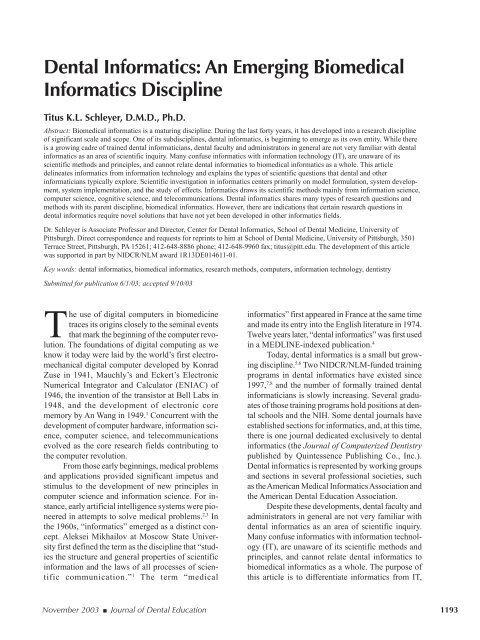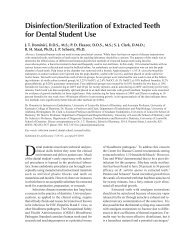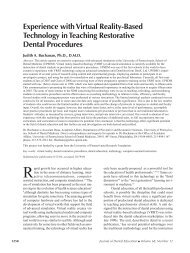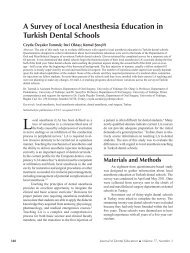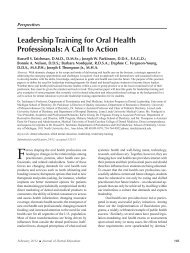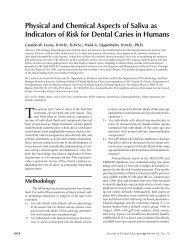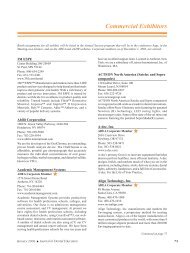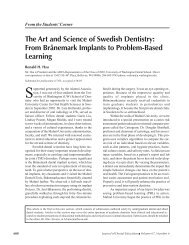Dental Informatics: An Emerging Biomedical Informatics Discipline
Dental Informatics: An Emerging Biomedical Informatics Discipline
Dental Informatics: An Emerging Biomedical Informatics Discipline
Create successful ePaper yourself
Turn your PDF publications into a flip-book with our unique Google optimized e-Paper software.
<strong>Dental</strong> <strong>Informatics</strong>: <strong>An</strong> <strong>Emerging</strong> <strong>Biomedical</strong><strong>Informatics</strong> <strong>Discipline</strong>Titus K.L. Schleyer, D.M.D., Ph.D.Abstract: <strong>Biomedical</strong> informatics is a maturing discipline. During the last forty years, it has developed into a research disciplineof significant scale and scope. One of its subdisciplines, dental informatics, is beginning to emerge as its own entity. While thereis a growing cadre of trained dental informaticians, dental faculty and administrators in general are not very familiar with dentalinformatics as an area of scientific inquiry. Many confuse informatics with information technology (IT), are unaware of itsscientific methods and principles, and cannot relate dental informatics to biomedical informatics as a whole. This articledelineates informatics from information technology and explains the types of scientific questions that dental and otherinformaticians typically explore. Scientific investigation in informatics centers primarily on model formulation, system development,system implementation, and the study of effects. <strong>Informatics</strong> draws its scientific methods mainly from information science,computer science, cognitive science, and telecommunications. <strong>Dental</strong> informatics shares many types of research questions andmethods with its parent discipline, biomedical informatics. However, there are indications that certain research questions indental informatics require novel solutions that have not yet been developed in other informatics fields.Dr. Schleyer is Associate Professor and Director, Center for <strong>Dental</strong> <strong>Informatics</strong>, School of <strong>Dental</strong> Medicine, University ofPittsburgh. Direct correspondence and requests for reprints to him at School of <strong>Dental</strong> Medicine, University of Pittsburgh, 3501Terrace Street, Pittsburgh, PA 15261; 412-648-8886 phone; 412-648-9960 fax; titus@pitt.edu. The development of this articlewas supported in part by NIDCR/NLM award 1R13DE014611-01.Key words: dental informatics, biomedical informatics, research methods, computers, information technology, dentistrySubmitted for publication 6/1/03; accepted 9/10/03The use of digital computers in biomedicinetraces its origins closely to the seminal eventsthat mark the beginning of the computer revolution.The foundations of digital computing as weknow it today were laid by the world’s first electromechanicaldigital computer developed by KonradZuse in 1941, Mauchly’s and Eckert’s ElectronicNumerical Integrator and Calculator (ENIAC) of1946, the invention of the transistor at Bell Labs in1948, and the development of electronic corememory by <strong>An</strong> Wang in 1949. 1 Concurrent with thedevelopment of computer hardware, information science,computer science, and telecommunicationsevolved as the core research fields contributing tothe computer revolution.From those early beginnings, medical problemsand applications provided significant impetus andstimulus to the development of new principles incomputer science and information science. For instance,early artificial intelligence systems were pioneeredin attempts to solve medical problems. 2,3 Inthe 1960s, “informatics” emerged as a distinct concept.Aleksei Mikhailov at Moscow State Universityfirst defined the term as the discipline that “studiesthe structure and general properties of scientificinformation and the laws of all processes of scientificcommunication.” 1 The term “medicalinformatics” first appeared in France at the same timeand made its entry into the English literature in 1974.Twelve years later, “dental informatics” was first usedin a MEDLINE-indexed publication. 4Today, dental informatics is a small but growingdiscipline. 5,6 Two NIDCR/NLM-funded trainingprograms in dental informatics have existed since1997, 7,8 and the number of formally trained dentalinformaticians is slowly increasing. Several graduatesof those training programs hold positions at dentalschools and the NIH. Some dental journals haveestablished sections for informatics, and, at this time,there is one journal dedicated exclusively to dentalinformatics (the Journal of Computerized Dentistrypublished by Quintessence Publishing Co., Inc.).<strong>Dental</strong> informatics is represented by working groupsand sections in several professional societies, suchas the American Medical <strong>Informatics</strong> Association andthe American <strong>Dental</strong> Education Association.Despite these developments, dental faculty andadministrators in general are not very familiar withdental informatics as an area of scientific inquiry.Many confuse informatics with information technology(IT), are unaware of its scientific methods andprinciples, and cannot relate dental informatics tobiomedical informatics as a whole. The purpose ofthis article is to differentiate informatics from IT,November 2003 ■ Journal of <strong>Dental</strong> Education 1193
Figure 2. <strong>Dental</strong> informatics combines two or more of its methodological foundations to addressproblems in practice, research, and education.formation, regardless of the medium. While the originsof information science predate the advent ofcomputers by almost 100 years, much of what is practicedas information science today would cease if notfor the computer. 26 Examples of how advances ininformation science assist us in our professional activitiesabound. Large literature databases such asMEDLINE could not function without controlledvocabularies, efficient databases, and query interfaces.Information design principles 27-29 make complexinformation more easily understood and analyzed.30 Text data mining methods transcend thecapabilities of human searchers and allow us to formulatenovel hypotheses. 31Computer science 32 is a discipline that involvesthe understanding and design of computers and computationalprocesses. Here, the emphasis is not oninformation, but how it is represented, processed,manipulated, and managed in computing systems.Computer science studies and develops data representations,algorithms, programming languages, operatingsystems, and computational approaches (suchas symbolic reasoning). One may assume that advancesin computer science occur primarily outsideof the biomedical informatics domain. While this islargely true, the attempt to solve medical problemshas resulted in some unique innovations in computerscience. For instance, biomedical informatics researchhas produced rule-based expert systems 3 anddomain-specific programming languages. 33Cognitive science 34 is a research area that drawson several fields (such as psychology, artificial intelligence,linguistics, and philosophy) to developtheories of perception, thinking, and learning. Thecentral hypothesis of cognitive science is that thinkingcan best be understood in terms of representationalstructures in the mind and computational proceduresthat operate on those structures. Cognitivescience relates to information science inasmuch wetry to understand how information is represented inthe human mind. It also relates to computer science,inasmuch we try to simulate our mental processes incomputing environments. Biomedicine is replete withcomplex cognitive processes (such as diagnosis,1196 Journal of <strong>Dental</strong> Education ■ Volume 67, Number 11
treatment planning, and evaluation). It is thereforeno surprise that cognitive science represents a significantcomponent of biomedical informatics research.35Finally, telecommunications 36 is the sciencethat deals with communication at a distance. Keyresearch issues in telecommunications include howcomputers communicate with each other, how communicationtraffic is routed, how bandwidth is usedmost efficiently, and how communication can be keptsecure. Advances in telecommunications tend to occurprimarily outside of biomedicine. However,sometimes biomedical problems provide importantstimuli for telecommunications research. For instance,the need to transmit digital images efficientlyresulted in new approaches to image compressionand transmission. 37 <strong>An</strong>other example is aggregatinginformation from many different sources, such asinformation about the same patient from differenthealthcare providers. In the United States, aggregatingsuch information is still a dream rather than areality and will require innovative approaches in cataloging,labeling, and transmitting patient-related information.The foundations of biomedical informatics donot rest exclusively on the four scientific areas describedhere. The social sciences and psychology helpelucidate the human factor in designing and implementingsystems and can provide important clues forwhy some implementations succeed and others fail.<strong>An</strong>thropology facilitates the understanding of thepersonal, cultural, and contextual environment inhealth care settings. Linguistics helps to codify andinterpret the language of biomedicine, and makesimportant contributions in representation and analysisof the free text commonly used in research, education,and patient care. Engineering provides globalunderpinnings for the design of systems anddevices, regardless of whether they are hardware orsoftware. 38<strong>Biomedical</strong> informatics borrows and/or derivesits methods, techniques, and theories from the scienceswe have discussed, and vice versa. This methodologicalfoundation is largely generic. For instance,ontologies are as useful in medicine as they are ingeography, botany, and philosophy. Neural networksmay assist in diagnosing pathologies in radiographs,filtering malicious traffic on computer networks, ordetecting enemy targets for military strikes.Datamining programs (software applications that siftthrough large amounts of data to find specific patternsor information) can help biomedical researchersfind patient records with particular clinical eventsas well as sift historical texts for geographic and temporalinformation.Yet the methods come alive for the practitioner,be it a researcher, clinician, or educator, only intheir practical application. As Figure 3 illustrates,many methods are applicable across the continuumof applied informatics disciplines. At the most granularlevel, bioinformatics is concerned with elucidatingmolecular and cellular processes. Imaginginformatics is primarily focused on the study of tissuesand organs. For the broad domain of clinicalinformatics, the individual patient is at the center ofinterest. Lastly, public health informatics is focusedon populations and society. It is important to notethat the interaction between basic and applied researchin informatics is a two-way street. Specificproblems in the applied area often result in the developmentof new methods, and new methods mayoffer alternative approaches to solving existing practicalproblems.Figure 3 makes also clear that informatics isnot equal to bioinformatics. Bioinformatics is simplyinformatics applied to the most granular level ofscience in biomedicine. While bioinformatics hasreceived a tremendous boost through the ongoingdecoding of the human genome, new insights intostructure-function relationships, and the potential toprevent or combat diseases beginning at the molecularlevel, it should be acknowledged that neither thesubject matter nor the scientific methods used areentirely novel. Bioinformatics applies well-establishedinformatics approaches, such as datamining,machine learning (software applications that learnfrom data, such as neural networks), statistics, andartificial intelligence, to achieve its aims. New and/or refined methods can emerge from these applications.In the next section, we explore how dentalinformatics relates to its parent discipline.<strong>Dental</strong> <strong>Informatics</strong> and ItsRelationship to <strong>Biomedical</strong><strong>Informatics</strong>How exactly discipline-based informatics areas(such as nursing informatics, dental informatics,pathology informatics) are related to biomedicalinformatics is subject to an ongoing debate. 24,39 Onone hand, it is understandable that established professionssuch as dentistry and nursing would like toNovember 2003 ■ Journal of <strong>Dental</strong> Education 1197
Figure 3. Relationship of basic research in biomedical informatics to the spectrum of applications in biomedicineBasic ResearchMedical <strong>Informatics</strong> Methods,Techniques, and TheoriesApplied ResearchBioinformaticsImaging<strong>Informatics</strong>Clinical<strong>Informatics</strong>Public Health<strong>Informatics</strong>Molecular andCellularProcessesTissues andOrgansIndividuals(Patients)Populations<strong>An</strong>d SocietySource: Shortliffe E, Johnson S. Medical informatics training and research at Columbia University. Yearbook of Medical <strong>Informatics</strong>2002;173-80. Reprinted with permission from Schattauer Verlag, Stuttgart, Germany.claim informatics as part of their domain. On theother hand, an excessive number of boundaries hasthe danger of balkanizing biomedical informatics asa whole.It is obvious that the spectrum of research questionsranging from the cellular and molecular levelto public health is similar in most clinical disciplines.It is also intuitive that most informatics methods aremore or less broadly applicable across this range ofresearch questions. The differences seem to clusterin the applied domain, where discipline-specific solutionsare most needed. To give a practical example,much energy, thought, and effort have been expendedon the development of computer-based patientrecords. 40 Many innovations in computerizing medicalrecords, however, have had little or no utility fordentistry. For instance, representational schemes andstandards for clinical data, such as the SNOMED,the Reed Codes, the ICD, and HL-7, typically don’trepresent dental concepts and data very well. Sincethe representations are not the same, computer systemsfor inputting, storing, managing, and analyzinginformation must necessarily differ. Differencesat the systems level, such as the practice setting(which in dentistry is heavily weighted towards thesolo practitioner model), the distribution of generalistsand specialists, and reimbursement schemes, alsotend to limit the transferability of theories, methods,and applications from one setting to another.However, despite the fact that many practicalproblems require discipline-specific solutions, broadand interdisciplinary collaboration within the biomedicalinformatics community seems to be one ofthe best ways to develop these solutions. As inclusiveand broad communities of researchers, such asthe American Medical <strong>Informatics</strong> Association, continueto illustrate, enormous opportunities for crossfertilizationand collaboration across health disciplinesexist. This spirit is also embodied in thephilosophies of most biomedical informatics trainingprograms 22,41,42 that train physicians, dentists,nurses, pharmacologists, computer scientists, and individualsfrom many other disciplines with curriculathat share a common core, but are adapted to theneeds of specific disciplines.1198 Journal of <strong>Dental</strong> Education ■ Volume 67, Number 11
ConclusionThe purpose of informatics is to solve practicalproblems for researchers, practitioners, and educators.Before informatics can be helpful, however,its “customers” must understand exactly whatinformatics is and what it is not. Unfortunately, confusionabout the nature, differences, and commonalitiesof informatics and IT has resulted in manymisconceptions and false starts. To be truly useful,informatics must be understood as what it is: a researchdiscipline aimed at uncovering generalizableprinciples. With a better understanding of its goalsand methods, individuals in applied areas will be ableto identify more easily how informatics could potentiallyhelp them in their own work. Conversely,informaticians must learn as much as possible aboutthe research issues and problems in the applied areas,so they can target their work at the resolution ofreal, fundamental problems.AcknowledgmentsThe author thanks Pat <strong>An</strong>derson and HeikoSpallek, as well as the reviewers, for their helpfulcomments and <strong>An</strong>drea Hyde for her assistance inpreparing the bibliography.REFERENCES1. Collen MF. A history of medical informatics in the UnitedStates.Washington, DC: American Medical <strong>Informatics</strong>Association, 1995.2. Ledley RS, Lusted LB. Reasoning foundations of medicaldiagnosis. Science 1959;130:9-21.3. Perry CA. Knowledge bases in medicine: a review. BullMed Libr Assoc 1990;78(3):271-82.4. Zimmerman JL, Ball MJ, Petroski SP. Computers in dentistry.Dent Clin North Am. 1986;30(4):739-43.5. Schleyer T. How should dental informatics evolve? J DentEduc 1996;60(3):291-5.6. Schleyer T, Spallek H. <strong>Dental</strong> informatics: a cornerstoneof dental practice. J Am Dent Assoc 2001;132(5):605-13.7. University of Pittsburgh Center for <strong>Dental</strong> <strong>Informatics</strong>.<strong>Dental</strong> informatics postgraduate program. 2000. At:di.dental.pitt.edu/programs/pg/. Accessed: October 24,2003.8. Columbia University. Columbia University biomedicalinformatics. 2000. At: www.dmi.columbia.edu/. Accessed:October 24, 2003.9. Shahar Y. Medical informatics: between science and engineering,between academia and industry. Methods InfMed 2002;41(1):8-11.10. Musen MA. Medical informatics: searching for underlyingcomponents. Methods Inf Med 2002;41(1):12-9.11. Maojo V, Martin F, Crespo J, Billhardt H. Theory, abstractionand design in medical informatics. Methods InfMed 2002;41(1):44-50.12. Patel VL, Kaufman DR. Science and practice: a case formedical informatics as a local science of design. J AmMed Inform Assoc 1998;5(6):489-92.13. Friedman CP. Where’s the science in medical informatics?J Am Med Inform Assoc 1995;2(1):65-7.14. Montironi R, Whimster WF, Collan Y, Hamilton PW,Thompson D, Bartels PH. How to develop and use a Bayesianbelief network. J Clin Pathol 1996;49(3):194-201.15. Bates DW, Ebell M, Gotlieb E, Zapp J, Mullins HC. Aproposal for electronic medical records in U.S. primarycare. J Am Med Inform Assoc 2003;10(1):1-10.16. 2000 survey of current issues in dentistry: dentists’ computeruse. Chicago: American <strong>Dental</strong> Association, 2001.17. White SC. Decision-support systems in dentistry. J DentEduc 1996;60(1):47-63.18. Kaplan B, Flatley Brennan P, Dowling AF, Friedman CP,Peel V. Toward an informatics research agenda: key peopleand organizational issues. J Am Med Inform Assoc2001;8(3):235-41.19. Friedman CP, Wyatt JC. Evaluation methods in medicalinformatics. New York: Springer, 1996.20. Friedman CP, Elstein AS, Wolf FM, Murphy GC, FranzTM, Heckerling PS, et al. Enhancement of clinicians’ diagnosticreasoning by computer-based consultation: amultisite study of 2 systems. JAMA 1999;282(19):1851-6.21. Musen M, van Bemmel JH. Challenges for medicalinformatics as an academic discipline. Methods Inf Med2002;41:1-3.22. Shortliffe E, Johnson S. Medical informatics training andresearch at Columbia University. Yearbook of Medical<strong>Informatics</strong> 2002;173-80.23. Covvey HD, Zitner D, Bernstein R, MacNeill JE. Thedevelopment of model curricula for health informatics.Medinfo 2001;10(Part 2):1009-13.24. Frisse ME, Musen MA, Slack WV, Stead WW. Howshould we organize to do informatics? Report of the ACMIDebate at the 1997 AMIA Fall Symposium. J Am MedInform Assoc 1998;5(3):293-304.25. Bose H. Information science: principles and practice. NewDelhi: Sterling Publishers Private Ltd., 1993.26. Kochen M. Principles of information retrieval. Los <strong>An</strong>geles:Melville Publishing Co., 1974.27. Tufte ER. The visual display of quantitative information.16th ed. Cheshire, Conn.: Graphics Press, 1983.28. Tufte ER. Envisioning information. Cheshire, Conn.:Graphics Press, 1990.29. Tufte ER. Visual explanations: images and quantities,evidence and narrative. Cheshire, Conn.: Graphics Press,1997.30. Powsner SM, Tufte ER. Graphical summary of patientstatus. Lancet 1994;344(8919):386-9.31. Swanson DR, Smalheiser NR. <strong>An</strong> interactive system forfinding complementary literatures: a stimulus to scientificdiscovery. Artificial Intelligence 1997;97:183-203.32. Dale NB, Lewis J. Computer science illuminated. Boston:Jones & Bartlett Publishers, 2002.November 2003 ■ Journal of <strong>Dental</strong> Education 1199
33. Bowie J, Barnett GO. MUMPS—an economical and efficienttime-sharing system for information management.Comput Programs Biomed 1976;6(1):11-22.34. Thagard P. Mind: introduction to cognitive science. Cambridge:MIT Press, 1996.35. Patel VL, Kaufman DR. Medical informatics and the scienceof cognition. J Am Med Inform Assoc 1998;5(6):493-502.36. Massey K, Baran S. Introduction to telecommunications.Columbus, OH: McGraw-Hill, 2000.37. Chang P, Betancourt C, McCurtain B, Lionetti D. Thedynamic transfer syntax canvas viewer: a high performanceand cost-effective thin client for enterprise-widelossless image distribution, collaboration and integration.85th Scientific Assembly and <strong>An</strong>nual Meeting, RSNA,Chicago, 1999.38. Rindfleisch TC. (Bio)Medical informatics in the next decade.J Am Med Inform Assoc 1998;5(5):416-20.39. Masys DR, Brennan PF, Ozbolt JG, Corn M, ShortliffeEH. Are medical informatics and nursing informatics distinctdisciplines? the 1999 ACMI debate. J Am Med InformAssoc 2000;7(3):304-12.40. Dick R, Steen E. The computer-based patient record.Washington, DC: National Academy Press, 1991.41. Musen MA. Stanford medical informatics: uncommonresearch, common goals. MD Computing 1999;January/February:47-50.42. University of Pittsburgh Center for <strong>Biomedical</strong><strong>Informatics</strong>. Center for <strong>Biomedical</strong> <strong>Informatics</strong>: the firstfour years. University of Pittsburgh, 2001.1200 Journal of <strong>Dental</strong> Education ■ Volume 67, Number 11


